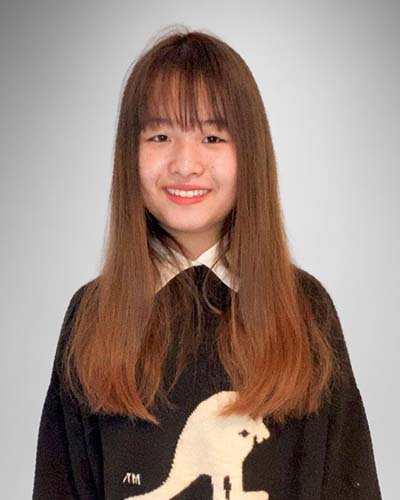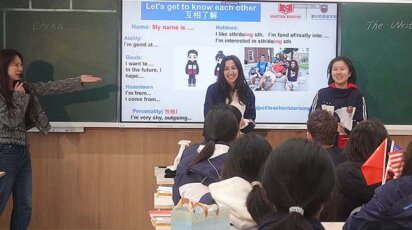News
Cosmologist Highlights Intersection of Physics and Social Justice
What is the universe made of and what is our relationship to it? Poly welcomed an expert guest speaker to help explain.
Dr. Chanda Prescod-Weinstein, a theoretical physicist specializing in early universe cosmology and author of The Disordered Cosmos: A Journey into Dark Matter, Spacetime, and Dreams Deferred, presented a virtual visit and Q&A answering those questions and more on April 6 in the library. Attendees received a copy of her book.

Dr. Prescod-Weinstein is a professor of physics, astronomy, and women’s and gender studies at the University of New Hampshire.
In inviting the community, Upper School physics teacher Jenna Peet said, “In The Disordered Cosmos, Dr. Chanda Prescod-Weinstein discusses her work as a theoretical physicist: how she fell in love with physics; the queerness of Einstein’s spacetime; her simultaneous fascination and frustration with ‘dark’ matter and the Standard Model of particle physics; and how the axion, the theoretical particle she focuses on, could resolve these open mysteries and provide insight into the development of our universe—fractions of a second after the Big Bang!”
“Physics is not acultural…”
Jenna Peet
“But, what really makes The Disordered Cosmos one of my favorite books,” Peet explained, “is that Dr. Prescod-Weinstein also uses this space to interrogate the intersection of science with social issues. Physics is not acultural; it is fraught with racism, sexism, colonialism, and other forms of oppression. Dr. Prescod-Weinstein examines the development of scientific understanding – and her own experiences in the field – through the lens of her identities as Black, femme, queer, and Jewish.”
The Right to Know the Night Sky
Librarian Iman Powe-Maynard welcomed guests to the presentation and Peet introduced Dr. Prescod-Weinstein for her talk, “The Right to Know and Love the Night Sky.”

Dr. Prescod-Weinstein, who grew up in East Los Angeles, said that as a child she could not see the starry night clearly because of the smog. Her interest in the whys and hows of the universe grew into a professional study of physics and dark matter. But, she writes, “Part of my science has to be rethinking not just how academia works but what I want science to do in the world.” She turned to Black feminism and found in Patricia Hill Collins’ book, six qualities of Black Feminist Thought, which she shared:
- Recognizes the significance of Black women’s thought as arising from their position as an oppressed group
- Connecting Black women’s experiences with the ideas that arise out of these experiences
- Black women are not a homogeneous group but nonetheless hold a shared standpoint that produces collective resistances
- African-American intellectuals merge action and theory to support ourselves and our communities
- Social justice change is a presumed feature and outcome of Black feminist thought
- Black feminist thought is always aware of the matrix of domination
Dr. Prescod-Weinstein pointed out that matrices are more suited to her as a physicist because of “how power is distributed and weighted.” As a Black feminist thinker, Dr. Prescod-Weinstein asks, “How can we find better ways to be in relationship with each other?”
“To be cut off from the night sky is to be cut off from our humanity.”
Dr. Chanda Prescod-Weinstein
She described first observing the night sky through a telescope and realizing her ancestors had seen that same sky. Dr. Prescod-Weinstein shared a cosmological timeline beginning with the “Big Bang” as a narrative of microwave to infrared to visible light as an “explanation of how we got here.”
We Are The Cosmos Weirdos
Spacetime has been defined as a mathematical model that joins space and time into a single idea called a continuum. In describing Einstein’s spacetime, Dr. Prescod-Weinstein explained that “spacetime is curved by massive objects” and that the earth is inside a curvature around the sun. And what is this universe made of? Dr. Prescod-Weinstein shared a pie chart illustrating that it is 68% dark energy, 27% dark matter, and 5% “normal matter,” which includes us. “We are the cosmos weirdos,” she said. Dr. Prescod-Weinstein opined that dark matter “should be called invisible matter.” In her book, she wrote, ”Existentially, dark matter is a reminder of how much we don’t know about the universe.”
“Science is shaped by the stories we tell and who matters and whose ideas count.”
Dr. Chanda Prescod-Weinstein

She explained that it was astronomer Dr. Vera C. Rubin, for whom an observatory in Chile is named, who found proof of the existence of dark matter. Early in her career, Dr. Prescod-Weinstein met Dr. Rubin and realized, “Science is shaped by the stories we tell and who matters and whose ideas count.” It occurred to Dr. Prescod-Weinstein, “My ideas counted.”
Dr. Prescod-Weinstein shared a 1967 Ebony magazine cover featuring Star Trek’s Nichelle Nichols, which was ironic because Black women were not part of NASA’s astronaut program at the time and not until Mae Jemison in 1987.
“We live in difficult times,” Dr. Prescod-Weinstein concluded, “but a better world is very much possible. It requires us to transform our relationships to power: how it is distributed and who it serves.”
Q&A with Physics Students

Dr. Prescod-Weinstein opened up the discussion to questions from the audience. Student Mary Lin ’24 asked what it is like to be a researcher and how Dr. Prescod-Weinstein deals with obstacles. “The practice of science is about what we don’t know,” Dr. Prescod-Weinstein answered. “Being a scientist means being confused a lot.” She shared that sometimes an “internal dialog” can be a barrier and cause self-doubt. Being a scientist, she said, also meant “being persistent, being patient” and sometimes stepping back and then returning to a problem.
On behalf of a student, Peet asked Dr. Prescod-Weinstein about the controversy surrounding the naming of NASA’s James Webb Telescope. Dr. Prescod-Weinstein explained her role in a published piece in Scientific American about why The James Webb Telescope Needs to Be Renamed. According to the article, Webb, who oversaw the Apollo program as NASA administrator, “was in part responsible for implementing what was by then federal policy: the purging of LGBT individuals from the workforce.”
A Lower School teacher, who was attending virtually, asked for a recommendation of Grades 3 & 4 STEM projects for students of color. But Dr. Prescod-Weinstein assured her that “students will be interested regardless of identity.” Children should be allowed to be curious about the natural world, she said.
Post Presentation Reactions

“After Dr. Chanda Prescod-Weinstein’s presentation,” said Reyhan Sanchez ’24, “I had begun reading her book, The Disordered Cosmos, and was surprised by how the book was fragmented into multiple topics about physics, race, cosmology, and childhood that blend in a unique fashion that doesn’t make itself apparent immediately, but creates an interactive narrative that goes deeper than just science.”
“What most stood out to me,” said Lin afterward, “is that Dr. Prescod-Weinstein stated that being a researcher is to be comfortable facing the unknown and the questions. She said to become a scientist is to seek the undiscovered and try to solve them. In addition, I was astonished by how little humanity knows about the universe. We have only discovered/perceived 5% of the universe which is referred to as ‘the normal matter,’ 68% are the dark energy, and 27% are the dark matter which are invisible to bare eyes.”
“It was only after Dr. Prescod-Weinstein explained the hardship female physicists encounter in the field of physics,” Lin said, “that I realized that even in science, a realm where facts should be the only factor that should be taken into consideration, sexists and racists still exist.”
“It was interesting to learn about the events that unfolded after the Big Bang,” added Leo Yang ’28, “Even though I don’t know much about this subject, It was cool to learn about the different elements that were behind and are still driving the expansion of the universe today.”



